
The bean weevils or seed beetles are a subfamily (Bruchinae) of beetles, now placed in the family Chrysomelidae, though they have historically been treated as a separate family. They are granivores, and typically infest various kinds of seeds or beans, living most of their lives inside a single seed. The subfamily includes about 1,650 species and are found worldwide.
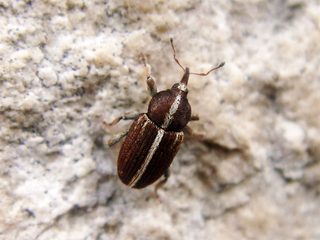
The beetle subfamily Curculioninae is part of the weevil family Curculionidae. It contains over 23,500 described species in 2,200 genera, and is therefore the largest weevil subfamily. Given that the beetle order (Coleoptera) contains about one-quarter of all known organisms, the Curculioninae represent one of the – if not the – most successful radiations of terrestrial Metazoa.

Staphylinoidea is a superfamily of beetles. It is a very large and diverse group with worldwide distribution.
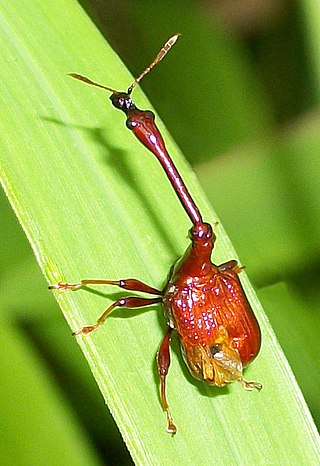
The Attelabidae is a widespread family of weevils. They are among the primitive weevils, because of their straight antennae, which are inserted near the base of the rostrum. The prothorax is much narrower than the base of the elytra on the abdomen. Attelabidae and the related family Rhynchitidae are known commonly as the leaf-rolling weevils. Rhynchitidae may be treated as subfamily Rhynchitinae of the Attelabidae.
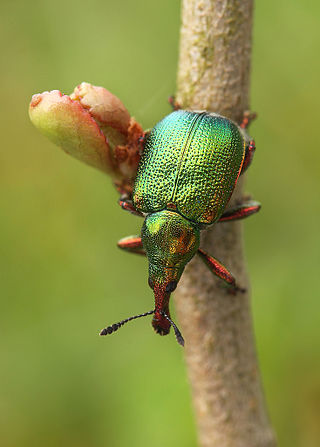
The tooth-nosed snout weevils, Rhynchitidae, are small beetles that are usually found in vegetation. They usually use buds, fruits, or seeds for oviposition. The tooth-nosed snout weevils receive this name due to the teeth on the edges of their mandibles.

The Entiminae are a large subfamily in the weevil family Curculionidae, containing most of the short-nosed weevils, including such genera as Entimus, Otiorhynchus, Phyllobius, Sitona, and Pachyrrhynchus. In comparison with their stunning diversity, only a few of these weevils are notorious pests of major economic importance. Entimines are commonly encountered in the field, including urban environments, and abundant in entomological collections.

Alleculinae is a subfamily of comb-clawed beetles belonging to the family Tenebrionidae. These beetles are characterized by an oval body, threadlike antennae, relatively long legs and tarsi quite elongated. Their most striking feature, however, are the combed claws of the hind tarsi, that show fine teeth.

Cossoninae is a true weevil subfamily in the family Curculionidae.

Geotrupinae is a subfamily of earth-boring scarab beetles in the family Geotrupidae. There are more than 30 genera and 450 described species in Geotrupinae.

Apioninae is a subfamily of pear-shaped weevils in the family of beetles known as Brentidae. There are at least 20 genera and 80 described species in Apioninae. They feed on living vegetation and sometimes on galls, making them occasional pests or tools of biological control.
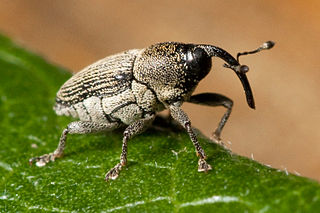
Apostasimerini is a tribe of flower weevils in the family of beetles known as Curculionidae. There are over 240 genera and nearly 1700 described species in Apostasimerini.
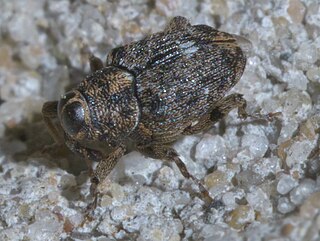
Conoderinae is a subfamily of true weevils in the beetle family Curculionidae. There are more than 210 genera in 15 tribes, and about 2,400 described species in Conoderinae.

Diaperinae is a subfamily of darkling beetles in the family Tenebrionidae. There are more than 120 genera in Diaperinae, grouped into 11 tribes.

Stenochiinae is a subfamily of darkling beetles in the family Tenebrionidae. There are more than 390 genera in Stenochiinae.
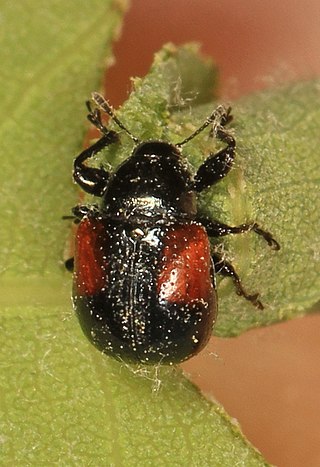
Attelabinae is a subfamily of leaf-rolling weevils in the beetle family Attelabidae. There are at least 20 genera and more than 690 described species in Attelabinae.

Mesoptiliinae is a subfamily of true weevils in the family Curculionidae. There are at about 23 genera and 40 described species in Mesoptiliinae.
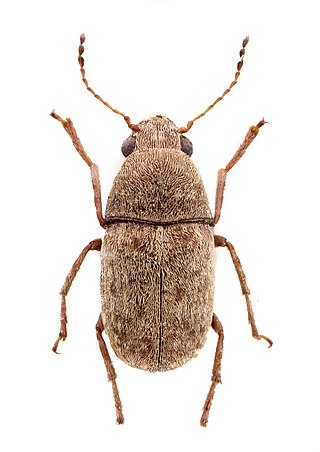
Choraginae is a subfamily of fungus weevils in the beetle family Anthribidae. There are about 9 genera and more than 180 described species in Choraginae.
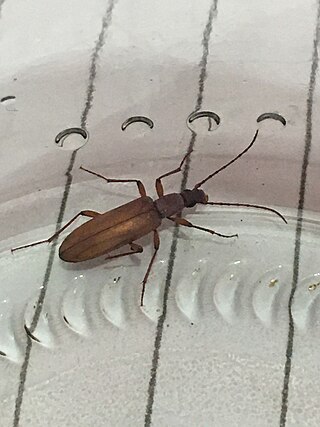
Evaniosomini is a tribe of darkling beetles in the subfamily Pimeliinae of the family Tenebrionidae. There are about eight genera in Evaniosomini, found primarily in the Neotropics.
Trilobocarini is a tribe of darkling beetles in the subfamily Pimeliinae of the family Tenebrionidae. There are about five genera in Trilobocarini, found mainly in the Neotropics.


















